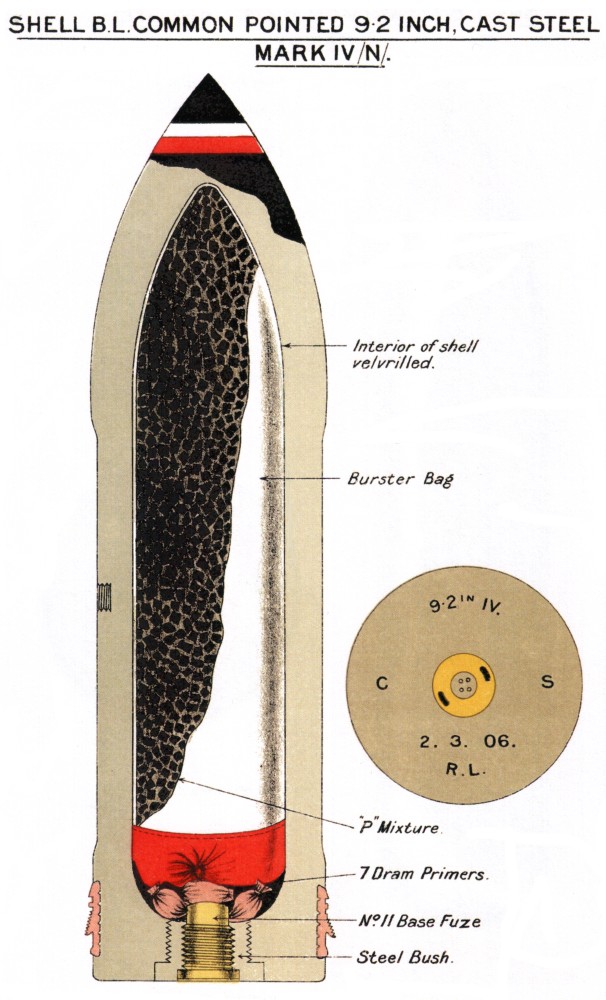I have a ww1 dated 6 inch trench mortar projectile which although recovered from near vimy ridge is in pretty good nick,what i dont know is what is the correct fuse? At the mo it has a brass plug fitted dated 1916,a no 80 fuse fits perfectly.Pics posted ,not sure if they will work. If not sorry spotter if you end up resizing again,i think my computer is as old as the mortar proj,Thanks chaps.
British Ordnance Collectors Network
You are using an out of date browser. It may not display this or other websites correctly.
You should upgrade or use an alternative browser.
You should upgrade or use an alternative browser.
WW1 British trench mortar fuse??????
- Thread starter tigbrand
- Start date
I agree it does have the outside shape of a common pointed naval shell.
Here's your bomb :

and here's the interior of Mk III bomb, I think the only change was the fins :

The walls and base are too thin for a high-velocity 6 inch naval common-pointed shell :
I don't have a diagram for 6-inch, but here's a 9.2 inch common-pointed shell. Note the thickness of walls and base :

Naval shells were heavy items, a 6-inch naval shell weighed 100 lb filled and fuzed and weere about 21 inches long. The Newton bomb weighed 52 lb and was about 18 inches long. Hence I don't see how the bomb was a converted naval shell unless they turned off a lot of the case, sawed 4 inches off the base, and added a new base i.e. bomb head. If the did that they could end up with the mortar bomb - but it doesn't seem worth the effort. Can you check your bomb where the joins are - does it appear as if the head is screwed on ?
Rod
Here's your bomb :

and here's the interior of Mk III bomb, I think the only change was the fins :

The walls and base are too thin for a high-velocity 6 inch naval common-pointed shell :
I don't have a diagram for 6-inch, but here's a 9.2 inch common-pointed shell. Note the thickness of walls and base :

Naval shells were heavy items, a 6-inch naval shell weighed 100 lb filled and fuzed and weere about 21 inches long. The Newton bomb weighed 52 lb and was about 18 inches long. Hence I don't see how the bomb was a converted naval shell unless they turned off a lot of the case, sawed 4 inches off the base, and added a new base i.e. bomb head. If the did that they could end up with the mortar bomb - but it doesn't seem worth the effort. Can you check your bomb where the joins are - does it appear as if the head is screwed on ?
Rod
Last edited:
Hi Rod,I no longer have this,its just been sold.You are right its not sturdy enough for a naval shell,also the casting is very crude indeed with porosity showing. Probably cast by a small foundry roped into munitions work! At the time i new very little about this round,Thanks for the additional info Tony.
Treatise on Ammunition 1915.
Velvrill was used to coat the inside of the shell, apparently to provide a smooth sealed surface.
Saltpetre in gunpowder apparently could cause the shell wall to corrode if it contained any moisture, which could damage both powder and shell. Presumably corrosion could be a source of friction with the powder on firing. So you don't want any chemical reactions going on.
Also, the smooth lining on the shell wall prevented friction with the gunpowder filling during firing, as friction could cause the gunpowder to ignite.
Velvril appears to have been an alternative to lacquer.
Composition of "velvril paint" :
zinc oxide 24 parts
yellow ochre 3.5
red iron oxide 0.5
nitrated castor oil 15
nitro-cellulose (low degree of nitration) 7.5
acetone oil 60
Velvrill was used to coat the inside of the shell, apparently to provide a smooth sealed surface.
Saltpetre in gunpowder apparently could cause the shell wall to corrode if it contained any moisture, which could damage both powder and shell. Presumably corrosion could be a source of friction with the powder on firing. So you don't want any chemical reactions going on.
Also, the smooth lining on the shell wall prevented friction with the gunpowder filling during firing, as friction could cause the gunpowder to ignite.
Velvril appears to have been an alternative to lacquer.
Composition of "velvril paint" :
zinc oxide 24 parts
yellow ochre 3.5
red iron oxide 0.5
nitrated castor oil 15
nitro-cellulose (low degree of nitration) 7.5
acetone oil 60
Last edited:







